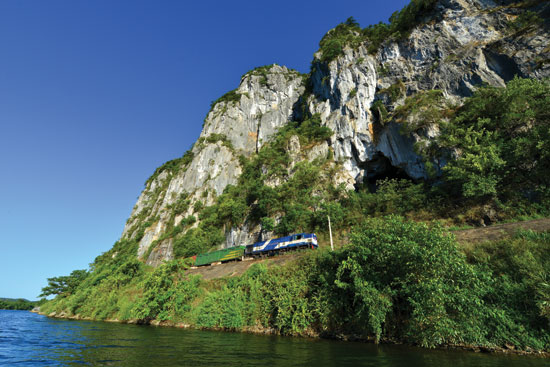No 3, Vol.12, November – December 2015

Railway running along Song Gianh River, Quang Binh Province.
Photos: Tran Binh An
Shinkansen (the bullet train) is known as the symbol of modern technology in Japan. Thailand is known as the best place around the world to try ‘tuk tuk’ travelling. In Vietnam, the ‘Reunification Railway’, a steel artery running the length of country, is an affordable and relatively comfortable transportation for locals and visitors alike.
Summer is the time for vacation. In Vietnam, trains frequently are chosen by families on long journeys, because of their safety and convenience. Night falls and wind makes the air cooler, driving the heat of summer day away. With a bag on my back, wearing a T-shirt and shorts, I got out of the cab and walked to the Hanoi railway station. The moment I stepped in the hall, I was surprised to see that it looks like a playground rather than a hall for people waiting for the trains. Children were chasing each other around with toys. Parents were chatting about their daily life’s stories; football matches for men, fashion and clothes for women. Smiles were on their faces because they knew that they were going to have some leisure time.
Railway running along Song Gianh River, Quang Binh Province.
Photos: Tran Binh An
From the station’s loudspeakers, the warm sound of a woman’s voice called the name of train, which was already prepared to welcome its passengers and required travellers enter Platform 1. Getting on the train, looking for my seat with the number printed on the ticket, one uniformed attendant for the Railways station helped me put luggage up to the hanger. A last urgent call in staccato Vietnamese filled the warm night air. After one long blast and one short toot on the horn, the train slid gently off into the night on its 33-hour, 1,070-mile journey to Vietnam’s second city, Ho Chi Minh City.
Seats include soft-chairs and soft-sleepers. Soft-chairs are arranged along both sides of the carriages, while soft-sleepers are divided into compartments with four sleepers for each one. I made myself comfortable with one soft-chair. On one corner of the train, young students were arguing about places they would visit when arriving and then they played cards. One family stayed in front of me, the mother singing a lullaby for her daughter. It had been a long day and sleep came easily in my soft-chair on the gently rocking train. 
Railway on way to Long Bien Bridge, Hanoi. Photo: Chitu Catalin
The next morning when I raised the blind, the sun was rising and rural Vietnam was running fast past the window; rice paddies, water buffalo, villages and farms. In the first 200 kilometres from Hanoi, civilization consists of crops of deep-water rice, villages with houses made from brick, banyan-trees and bamboo trees.
Pagodas made from wood represent Mahayana Buddhism, the most thriving religion in the Vietnamese ancient kingdoms, while temples represent Confucianism. After crossing the north middle mountainous area of Vietnam, the train reached Hai Van pass, the present internal administrative border line between Hue province and Da Nang city, also the natural border line between ancient kingdoms in Vietnam and the cultural border line between Confucianism and Mahayana Buddhism in the North with Hinduism and Theravada Buddhism in the South.
Through the train’s windows, I saw whole scene of empty beaches, islands and sea. The train slowed to an easy ramble and clambered into the hills, hugging the cliffs, with the sea breaking on the rocks below.
The railway ducked under the higher peaks in a series of tunnels. On this trip, the pass was covered with thousands of white blossoms on both sides of the railway; it made one of the most incredible scenes I have ever seen in my life. 
Railway running along Nguyen Thai Hoc St, Hanoi. Photo: Trinh Minh Khoi
Crossing over the Hai Van pass, the train reached Danang city – the city of the International firework contest for the last two years and the main gate to Hoi An ancient town for visitors.
Up to this point, the train had travelled along the coastal area of Middle Vietnam, the area of Champa, one ancient kingdom in Vietnam. The Cham minority, descendants of the Champa kingdom, still maintain their ancestors’ way of life and cultural heritage. Cham temples are preserved perfectly; they believe in Brahma, Vishnu and Shiva-the Hindu Gods trinity. In the golden age of Champa’s ancient kingdom, from the 9th to the 10thcentury, in the middle of Vietnam, the Cham inhabited a vast territory, leaving behind original construction and specific cultural treasures.
The smell of seawater following the wind flows into the train’s carriages. Sunshine leaks through windows. White sand hills lay on both sides of the railway.
Saigon appears on maps as Ho Chi Minh City, the last destination on the railway. Saigon makes an interesting contrast with its northern counterpart, but whether it’s Hanoi or Saigon, travelling by train at least one time in Vietnam is always the best choice.n
The train ticket from Hanoi to Saigon costs about VND1,000,000 to VND1,100,000 for soft-chair, and from VND1,300,000 to VND1,400,000 for soft-sleepers.

